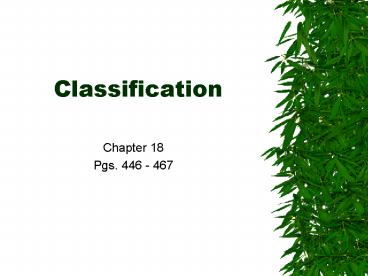Classification - PowerPoint PPT Presentation
1 / 32
Title:
Classification
Description:
Turdus migratorius (American Robin) Linnaeus's System of Classification ... Volcanic hot springs, brine pools, black organic mud devoid of oxygen ... – PowerPoint PPT presentation
Number of Views:30
Avg rating:3.0/5.0
Title: Classification
1
Classification
- Chapter 18
- Pgs. 446 - 467
2
18-1 Finding Order in Diversity
3
Why Classify?
- To study the diversity of life, biologists use a
classification system to name organisms and group
them in a logical manner. - Taxonomy
- The branch of biology concerned with the grouping
and naming of organisms
4
Assigning Scientific Names
- Why common names are confusing.
- Felis concolor has 4 common names
- Mountain lion, a puma, a cougar, or a panther
- A common name can refer to 2 different species
example is buzzard in the UK it refers to a
hawk and in most of the US it refers to a vulture
5
- Binomial nomenclature
- Developed by Linnaeus
- Two-word system to name organisms
- Are always in Latin and Must be italicized or
underlined - The first word (genus) is capitalized but the
second word (descriptive term) is lowercase - Turdus migratorius (American Robin)
6
Linnaeuss System of Classification
- Linnaeuss hierarchical system of classification
includes seven levels. They are from smallest
to largest species, genus, family, order,
class, phylum, and kingdom. - Taxon each level within a naming system.
- (commonly memorized from largest to smallest)
- King Philip Came Over For Grannys Spaghetti
7
(No Transcript)
8
- Species
- Organisms that look alike
- Successfully reproduce among themselves
- Genus
- Group of closely related species
- Family
- Group of closely related genera
9
- Order
- Group of related families
- Class
- Group of related orders
- Phylum/Divisions
- Group of related classes
- Kingdom
- Group of related phyla
10
How Living Things are Classified
- Differences between plant and animal
classification - Animal groups are called phyla (phylum)
- Plant groups are called divisions
11
(No Transcript)
12
Dichotomous Key
- Is a set of paired statements that can be used to
identify organisms - You choose one statement from each pair that best
describes the organism - At the end you will identify the name or what
group the organism belongs to
13
Complete Lab on pg. 462-462 Part A
- I -
- II -
- III -
- IV -
- V -
- VI -
- VII -
14
18-2 Modern Evolutionary Classification
15
Evolutionary Classification
- Phylogeny
- The evolutionary relationship among organisms
- Cladogram
- A diagram that shows the evolutionary
relationships among a group of organisms
16
Cladogram
17
18-3 Kingdoms and Domains
18
The Tree of Life Evolves
- The number of kingdoms have increased from five
to six in the past few years - The six-kingdom system of classification includes
the kingdoms Eubacteria, Archaebacteria,
Protista, Fungi, Plantae, and Animalia
19
The Three-Domain System
- Domain a more inclusive category than any other
larger than a kingdom - The 3 domains are
- Eukarya (include protists, fungi, plants, and
animals) - Bacteria (corresponds to Eubacteria)
- Archaea (corresponds to Archaebacteria)
20
Domain Bacteria
- Corresponds to the kingdom Eubacteria
- Contains all unicellular, prokaryotic cells
- Have thick, rigid cell walls
- Either heterotroph or autotroph
- Some need oxygen while others are killed by
oxygen - Example Strepococcus, Escherichia coli
21
Domain Archaea
- Corresponds to kingdom Archaebacteria
- Contain all prokaryotic cells
- Live in some of the most extreme environments
- Volcanic hot springs, brine pools, black organic
mud devoid of oxygen - Most can survive only in the absence of oxygen
- Examples Methanogens, halophiles
22
Domain Eukarya
- Consist of all organisms that have a nucleus
- Organized into 4 kingdoms
- Protista, Fungi, Plantae, and Animalia
23
- Protista
- Members display the greatest variety
- Most are unicellular but some are multicellular
- Either autotroph or heterotroph
- Examples
- Amoeba, paramecium, giant kelp
24
(No Transcript)
25
- Fungi
- A unicellular or multicellular heterotrophic
eukaryote - Absorbs nutrients obtained by decomposing dead
organisms and wastes in the environment - Examples
- Mushrooms, which are multicellular
- Yeasts, which are unicellular
26
(No Transcript)
27
- Plantae
- Multicellular organisms that are photosynthetic
autotrophs - Nonmotile cannot move from place to place
- Contain cell walls
- Includes cone-bearing and flowering plants, as
well as mosses and ferns
28
(No Transcript)
29
- Animalia
- Multicellular consumers that eat and digest other
organisms for food - Animal cells have no cell wall
- Most are motile for at least some part of their
life cycle - Incredible amount of diversity
- Sponges, worms, insects, fish, mammals
- Many exist in nearly every part of the planet
30
(No Transcript)
31
(No Transcript)
32
(No Transcript)

